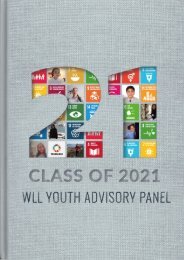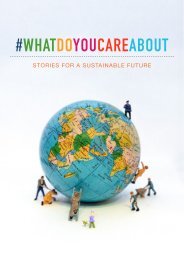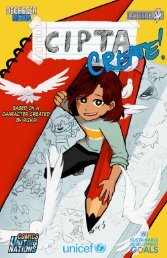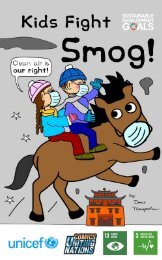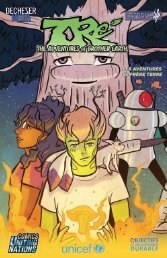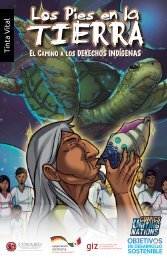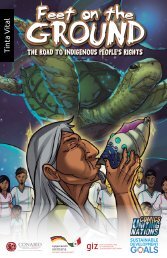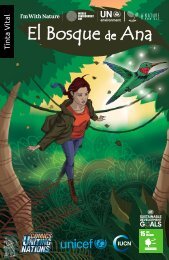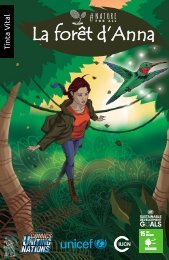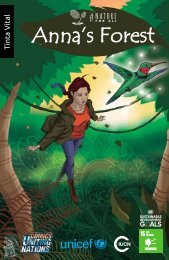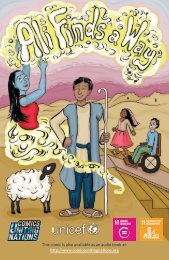The Voice of an Island
You also want an ePaper? Increase the reach of your titles
YUMPU automatically turns print PDFs into web optimized ePapers that Google loves.
Isl<strong>an</strong>d<br />
<strong>The</strong> <strong>Voice</strong> <strong>of</strong> <strong>an</strong><br />
by<br />
Lupe Vaai<br />
Illustrated by Li-Wen Chu
Published <strong>an</strong>d distributed by:<br />
<strong>Voice</strong>s <strong>of</strong> Future Generations International Children’s Book Series<br />
Trust for Sustainable Living<br />
Hampstead Norreys, Berkshire, RG18 0TN, United Kingdom<br />
Tel: +44 (0)1635 202444<br />
Web: www.v<strong>of</strong>g.org<br />
Special th<strong>an</strong>ks to René V. Steiner for layout <strong>an</strong>d graphics support:<br />
www.steinergraphics.com.<br />
Text © Lupe Vaai 2017<br />
Illustrations © Li-Wen Chu 2017<br />
<strong>The</strong> <strong>Voice</strong>s <strong>of</strong> Future Generations International Children’s Book Series:<br />
‘<strong>The</strong> Epic Eco-Inventions’ by Jona David (Europe/North America), illustrated by Carol Adlam<br />
‘<strong>The</strong> Great Green Vine Invention’ by Jona David (Europe/North America), illustrated by Carol Adlam<br />
‘<strong>The</strong> Tree <strong>of</strong> Hope’ by Kehkash<strong>an</strong> Basu (Middle East), illustrated by Karen Webb-Meek<br />
‘<strong>The</strong> Fireflies After the Typhoon’ by Anna Kuo (Asia), illustrated by Siri Vinter<br />
‘<strong>The</strong> Species-Saving Time Team’ by Lautaro Real (Latin America), illustrated by D<strong>an</strong> Ungure<strong>an</strong>u<br />
‘<strong>The</strong> Sisters’ Mind Connection’ by Allison Liev<strong>an</strong>o-Gomez (Latin America), illustrated by Oscar Pinto<br />
‘<strong>The</strong> Forward <strong>an</strong>d Backward City’ by Diwa Boateng (Africa), illustrated by Meryl Treatner<br />
‘<strong>The</strong> <strong>Voice</strong> <strong>of</strong> <strong>an</strong> Isl<strong>an</strong>d’ by Lupe Vaai (Pacific Isl<strong>an</strong>ds), illustrated by Li-Wen Chu<br />
‘<strong>The</strong> Visible Girls’ by Tyronah Sioni (Pacific Isl<strong>an</strong>ds), illustrated by Kasia Nieżywińska<br />
‘<strong>The</strong> Mech<strong>an</strong>ical Chess Invention’ by Jona David (Europe/North America), illustrated by D<strong>an</strong> Ungure<strong>an</strong>u<br />
CISDL<br />
Centre for International<br />
Sustainable Development Law<br />
This book is printed on recycled paper, using sustainable <strong>an</strong>d low-carbon printing methods.
<strong>The</strong><br />
<strong>Voice</strong> <strong>of</strong> <strong>an</strong> Isl<strong>an</strong> d<br />
by<br />
Lupe Vaai<br />
Illustrated by Li-Wen Chu<br />
3
4
prefaces<br />
<strong>The</strong> <strong>Voice</strong> <strong>of</strong> <strong>an</strong> Isl<strong>an</strong>d by Lupe Va’ai is <strong>an</strong> import<strong>an</strong>t<br />
contribution to children <strong>an</strong>d young adults’ literature from the<br />
Pacific. This book is especially inspirational since it is written<br />
with the insight <strong>an</strong>d clarity <strong>of</strong> a young Pacific Isl<strong>an</strong>der, <strong>an</strong> heir<br />
or suli to the legacies left by her elders, particularly in terms<br />
<strong>of</strong> the environment, which is <strong>of</strong>ten labelled a paradise by its<br />
indigenous inhabit<strong>an</strong>ts <strong>an</strong>d visitors from abroad.<br />
<strong>The</strong> contemporary Samo<strong>an</strong> world with its challenges <strong>of</strong><br />
climate ch<strong>an</strong>ge <strong>an</strong>d modernity which have been highlighted<br />
by the young author is impressively realistic <strong>an</strong>d her major character, Katalina, with the<br />
initiative <strong>of</strong> setting up Green Teams makes her a heroine <strong>an</strong>d a champion <strong>of</strong> conserving<br />
<strong>an</strong>d protecting the environment.<br />
Lupe is to be congratulated as <strong>an</strong> import<strong>an</strong>t literary voice for our young generation. Her<br />
story is a call to action to take small, do-able <strong>an</strong>d practical steps towards healing our isl<strong>an</strong>d<br />
environments <strong>an</strong>d keeping them special.<br />
Dr Sina Va’ai<br />
Pr<strong>of</strong>essor <strong>of</strong> English, Faculty <strong>of</strong> Arts, National University <strong>of</strong> Samoa, Apia<br />
5
<strong>The</strong> pages <strong>of</strong> this book represent rays <strong>of</strong> sunlight on our<br />
future.<br />
In this day <strong>an</strong>d age when the challenges <strong>of</strong> today’s world<br />
<strong>an</strong>d m<strong>an</strong>kind’s impact on our pl<strong>an</strong>et are overwhelming, this<br />
story <strong>of</strong> hope <strong>an</strong>d ch<strong>an</strong>ge by Lupe Va’ai instills faith that<br />
a difference c<strong>an</strong> <strong>an</strong>d will be made through the minds <strong>an</strong>d<br />
actions <strong>of</strong> our future generation.<br />
It is not every day that a child writes a story at the age <strong>of</strong> 11,<br />
especially one on such a crucial issue, <strong>an</strong>d that gives us cause to celebrate.<br />
Lupe, at such a young age, instills in us all the confidence that we will achieve a better<br />
pl<strong>an</strong>et <strong>an</strong>d environment. We c<strong>an</strong> do this together, it’s in our h<strong>an</strong>ds.<br />
N<strong>an</strong>ette Woonton<br />
Media & Public Relations Officer, A/Communications & Outreach Adviser,<br />
Secretariat <strong>of</strong> the Pacific Regional Environment Programme (SPREP), Apia<br />
6
Where climate ch<strong>an</strong>ge is one <strong>of</strong> the biggest challenges facing<br />
our generation, a determined schoolgirl decides to take matters<br />
into her own h<strong>an</strong>ds.<br />
Growing up in a polluted environment filled with dust <strong>an</strong>d<br />
rubbish, Katalina makes up her mind that this is not the<br />
future she w<strong>an</strong>ts to see for herself, her family <strong>an</strong>d her friends.<br />
How she longs for the fresher air <strong>an</strong>d greener pastures in her<br />
gr<strong>an</strong>dmother’s stories!<br />
So begins her journey to tackle the problems around her: a journey which takes her from<br />
a tiny isl<strong>an</strong>d in the Pacific all the way to New York to show that no matter how small you<br />
are, you too c<strong>an</strong> make a dent in the world.<br />
As <strong>an</strong> avid reader <strong>an</strong>d blogger, I find this to be <strong>an</strong> articulate <strong>an</strong>d thoughtful story <strong>of</strong> the<br />
environmental challenges facing small isl<strong>an</strong>d nations that are most vulnerable to the effects<br />
<strong>of</strong> climate ch<strong>an</strong>ge. Moreover, as a book written from the point <strong>of</strong> view <strong>of</strong> a Pacific student,<br />
it is a must for all school libraries!<br />
Sita Leota<br />
Audit Director, Samoa Audit Office<br />
7
8
chapter<br />
1<br />
<strong>The</strong> dust was <strong>an</strong>noying, causing people eyesores as well as non-stop coughing.<br />
Sitting silently in the corner <strong>of</strong> the house, Katalina thought <strong>of</strong> the beautiful<br />
stories her gr<strong>an</strong>dma used to tell her, about a lush, green place with colourful<br />
flowers all around <strong>an</strong>d tried to imagine the stories <strong>of</strong> natural beauty <strong>of</strong> her l<strong>an</strong>d<br />
growing up, compared to the dry, dusty <strong>an</strong>d ugly place she was now living in.<br />
Her gr<strong>an</strong>dma used to describe their home as if it was paradise, where she talked<br />
<strong>of</strong> birds <strong>an</strong>d <strong>an</strong>imals in a place so beautiful <strong>an</strong>d untouched.<br />
9
Katalina tried to imagine that same place now in her mind. It was hard. She<br />
was continuously struggling with the realities <strong>of</strong> a place that was so different<br />
from her gr<strong>an</strong>dma’s stories – a place all dried up with dust all around, litter<br />
everywhere <strong>an</strong>d the air so polluted one could hardly see beyond the once<br />
admired beautiful gardens <strong>of</strong> Vailima. Every day, as she walked to school,<br />
she would see her neighbours throwing rubbish down the hills <strong>of</strong> the Alaoa<br />
Valley, families burning their rubbish in the backyards <strong>an</strong>d big comp<strong>an</strong>ies<br />
cutting down forests <strong>of</strong> trees. She felt hopeless as a kid, that she could not<br />
in <strong>an</strong>y way tell them to stop.<br />
10
It was <strong>an</strong>other ordinary day, sunny, polluted <strong>an</strong>d mostly dusty. When she<br />
arrived at the entr<strong>an</strong>ce <strong>of</strong> her school, Katalina saw the students throwing<br />
plastic bottles, twisty bags <strong>an</strong>d other rubbish into the school incinerator. As<br />
she walked to her classroom, she could smell the strong smoke as it filled<br />
up the whole compound. It was like seeing her own country die before<br />
her very eyes. No one seemed to mind. No one seemed to worry. No one<br />
seemed to pay <strong>an</strong>y attention to the little things that were slowly destroying<br />
her gr<strong>an</strong>dma’s paradise.<br />
11
Katalina felt trapped somewhere where she could not break free. She felt<br />
guilty that she was a part <strong>of</strong> this madness. <strong>The</strong> images in her gr<strong>an</strong>dma’s<br />
stories were something that were simply in a story, far away from the reality<br />
<strong>of</strong> the rubbish lying around staring at her <strong>an</strong>d <strong>of</strong> the pollution that was<br />
surrounding her everyday <strong>of</strong> her life. It did not matter how hard she tried to<br />
h<strong>an</strong>g on to those memories. <strong>The</strong> truth about her life now was very much real<br />
<strong>an</strong>d would not disappear. She just had to live with it.<br />
12
At school that day, Katalina could not focus because <strong>of</strong> the heat. <strong>The</strong> only<br />
escape was to the library <strong>an</strong>d to the teachers’ staff room, where there was air<br />
conditioning throughout the day. As she finished her class chores for the<br />
day, she was very tired from the heat. <strong>The</strong> school water supply was being<br />
rationed due to long periods <strong>of</strong> hot weather without rain. She could smell<br />
the smoke <strong>an</strong>d hear the sounds from the huge trucks that were tr<strong>an</strong>sporting<br />
logs from the Ah Li property to the Chinese factory down at the end <strong>of</strong> the<br />
road from the school.<br />
13
As she walked home, sweating from the rising temperatures <strong>of</strong> the late<br />
afternoon, she kept thinking that this must really be the end <strong>of</strong> the road for<br />
Samoa. She could feel her skin getting sun burnt. <strong>The</strong>re were hardly <strong>an</strong>y<br />
trees for shade along the road. She could see the other people struggling<br />
in the heat <strong>of</strong> the sun.<br />
Arriving home, Katalina stood face-to-face with the most shocking sight.<br />
Her family was part <strong>of</strong> this whole story playing out in her mind. <strong>The</strong>y were<br />
also contributing to the slow destruction <strong>of</strong> gr<strong>an</strong>dma’s paradise.<br />
14
All air conditioners in the house were on full blast. Her dad’s tr<strong>an</strong>sport<br />
business provided customers with bus services with full air-conditioning,<br />
<strong>an</strong>d exhaust fumes filling the air. Old vehicle parts filled up one corner <strong>of</strong><br />
their property <strong>an</strong>d slowly being used as a rubbish heap. She remembered<br />
overhearing one time that they were pl<strong>an</strong>ning to dump them in Fagaloa Bay,<br />
as they were not allowed to take them to the Tafaigata l<strong>an</strong>dfill. Katalina<br />
thought it was also expensive for her dad to take them there.<br />
15
Katalina could only think <strong>of</strong> her gr<strong>an</strong>dma <strong>an</strong>d how she would not w<strong>an</strong>t<br />
her paradise to get <strong>an</strong>y worse th<strong>an</strong> what Katalina was already experiencing.<br />
Katalina r<strong>an</strong> outside <strong>an</strong>d told her father’s workers to stop all the madness<br />
they were doing. Her father was <strong>an</strong>gry <strong>an</strong>d asked Katalina why she made<br />
the workers stop working.<br />
16
Katalina explained to him about her gr<strong>an</strong>dma’s stories. She tried to show<br />
him what his business was doing to their quality <strong>of</strong> life. She told him <strong>of</strong><br />
the ch<strong>an</strong>ges to the climate in Samoa including, why it is getting terribly<br />
hot <strong>an</strong>d how the smoke from the buses <strong>an</strong>d trucks as well as the rubbish<br />
contributes to these ch<strong>an</strong>ges. But her father just laughed <strong>an</strong>d told her that<br />
she was a very smart girl. He called her his ‘little Einstein’, affectionately,<br />
but then <strong>an</strong>swered that he was earning their living from doing this work.<br />
Samoa, he explained, was only a small place on earth, it would not matter<br />
what they did because the bigger countries were doing much bigger things<br />
that had bigger impacts. He also told her that the earth was made for<br />
hum<strong>an</strong>s to use <strong>an</strong>d destroy. It is their place to do what they w<strong>an</strong>t, <strong>an</strong>d<br />
Samoa was me<strong>an</strong>t to be hot.<br />
17
After talking to him, Katalina became very depressed <strong>an</strong>d went to her room.<br />
She loved her father, but she could not believe he really understood what<br />
she was feeling <strong>an</strong>d how she strongly wished for a way to restore her isl<strong>an</strong>d<br />
to her gr<strong>an</strong>dma’s paradise. She prayed for ideas <strong>an</strong>d tried to think <strong>of</strong> how to<br />
seek help. She was only a young girl <strong>an</strong>d she had no idea how to reach out.<br />
She was also starting to doubt whether she was right or not <strong>an</strong>d whether<br />
Samoa, like her dad said, was just me<strong>an</strong>t to be used <strong>an</strong>d destroyed like this.<br />
18
chapter<br />
2<br />
It was still boiling hot <strong>an</strong>d horribly dusty that afternoon. While walking home<br />
from school, Katalina saw cars passing her. Young children <strong>an</strong>d adults were<br />
throwing rubbish out the windows. Last week’s decorations to welcome the “All<br />
Blacks” to Samoa were littering the roadside. Fast food wrappers were in the<br />
ditches with the stray dogs going<br />
through them. <strong>The</strong> barbeque stall<br />
opposite the school was using<br />
firewood <strong>an</strong>d black smoke was<br />
filling the air.<br />
That night, Katalina could not sleep,<br />
due to all the thoughts rushing<br />
around in her young mind. She<br />
took a deep breath <strong>an</strong>d closed her<br />
eyes. She kept thinking about the<br />
unfairness <strong>of</strong> growing up without<br />
being able to witness the same life<br />
<strong>an</strong>d beauty that her gr<strong>an</strong>dma did.<br />
19
Startled by the loud roar <strong>of</strong> trucks down the Cross Isl<strong>an</strong>d road, Katalina<br />
awoke early, into yet <strong>an</strong>other cloud <strong>of</strong> dust. She sighed, got ready <strong>an</strong>d<br />
walked to school. She was frustrated. She knew there had to be something<br />
she could do.<br />
20
21
Arriving at school, Katalina patiently waited in her assigned seat for the<br />
teacher. She thought <strong>of</strong> all the positive <strong>an</strong>d negative impacts on Samoa,<br />
especially on her family <strong>an</strong>d her village <strong>of</strong> Siumu. In Katalina’s head, she<br />
was determined to save her Isl<strong>an</strong>d. She was just not sure how to go about<br />
it. She was not even sure how to bring her ideas up. <strong>The</strong>y were learning<br />
about the world’s Sustainable Development Goals. <strong>The</strong> teacher explained<br />
how m<strong>an</strong>y concerns had been recognised by the leaders <strong>of</strong> all countries<br />
at the United Nations <strong>an</strong>d how everyone had committed to stop climate<br />
ch<strong>an</strong>ge <strong>an</strong>d to build a better quality <strong>of</strong> life for everyone. Katalina raised her<br />
h<strong>an</strong>d. She explained about her gr<strong>an</strong>dma’s stories <strong>an</strong>d her own research. Her<br />
teacher listened <strong>an</strong>d so did the class. It is best to try <strong>an</strong>d fail th<strong>an</strong> fail to try,<br />
they said.<br />
22
23
At break, Katalina stayed inside <strong>an</strong>d started to research the things she was<br />
seeing. She came across some discussions on climate ch<strong>an</strong>ge <strong>an</strong>d justice<br />
<strong>an</strong>d the United Nations Framework Convention on Climate Ch<strong>an</strong>ge. She<br />
also found a guide to children’s environmental rights, which are protected<br />
in the United Nations Framework Convention on Climate Ch<strong>an</strong>ge <strong>an</strong>d<br />
Convention on the Rights <strong>of</strong> the Child. She understood that her concerns<br />
were shared by m<strong>an</strong>y, m<strong>an</strong>y others. She saw that promises had been made<br />
<strong>an</strong>d that everyone had a role to help fulfil them.<br />
Straight after school, Katalina raced home. <strong>The</strong> sun was beating down on<br />
her head, which felt like a p<strong>an</strong> on a woodfire stove. But she had <strong>an</strong> idea.<br />
No matter how small it was, she was going to try it. At her house, Katalina<br />
started to list all the positive <strong>an</strong>d negative impacts <strong>of</strong> the people <strong>of</strong> Samoa<br />
continuing with their current habits <strong>an</strong>d lifestyles.<br />
24
Positive Impacts<br />
People continue to enjoy what they do<br />
More development in the country<br />
More money <strong>an</strong>d resources to spend<br />
More fast-food, fossil fuels <strong>an</strong>d<br />
fashion to use <strong>an</strong>d throw away<br />
Negative Impacts<br />
Cutting down trees will me<strong>an</strong> less<br />
cle<strong>an</strong> air <strong>an</strong>d the d<strong>an</strong>ger <strong>of</strong> l<strong>an</strong>dslides<br />
Burning <strong>an</strong>d littering will keep<br />
polluting the air<br />
Sea level will rise <strong>an</strong>d we will all have<br />
to leave Samoa<br />
More natural disasters in our country,<br />
destroying our homes, <strong>an</strong>d no supplies<br />
to rebuild <strong>an</strong>d restore<br />
Katalina’s list kept growing, especially on the negative side. She made up<br />
her mind she was going to put her pl<strong>an</strong> into action. She knew she was<br />
not going to solve the problem overnight, but felt that if she could take<br />
a little step, then it may be worth something. She picked up her camera<br />
<strong>an</strong>d slipped away from her house, a clear mission in her mind. When she<br />
returned several hours later, she was both sad <strong>an</strong>d inspired. She could not<br />
wait to go to school the next day, to take the next step in her pl<strong>an</strong>.<br />
25
chapter<br />
3<br />
<strong>The</strong> next morning, Katalina woke up with her mission on her mind. Even<br />
the cloud <strong>of</strong> dust flowing unforgivingly around her house, which had<br />
become a nearly normal part <strong>of</strong> her everyday life, did not stop her from<br />
getting ready quickly <strong>an</strong>d rushing <strong>of</strong>f to school.<br />
26
At school, she knocked on the door <strong>of</strong> her principal, Sr Masela. In order to<br />
get her message across, Katalina brought photographs <strong>of</strong> the sad situations<br />
that she was seeing everyday. <strong>The</strong> pictures told a thous<strong>an</strong>d stories. <strong>The</strong>y<br />
showed beaches covered by the waves, birds struggling in the oil <strong>an</strong>d<br />
plastic floating on the tide, rubbish littering the roads, smoke pouring<br />
from factories, <strong>an</strong>d children coughing in the dust. Sr. Masela’s pledged<br />
her support for Katalina to set up the first ever Green Team at St Mary’s<br />
School. This became Katalina’s project for the next few weeks. She was<br />
given the opportunity to speak at assembly. She explained what her new<br />
Green Team would be doing. With her teachers <strong>an</strong>d friends from all years,<br />
she set up a point system to encourage all students to learn more about the<br />
environment <strong>an</strong>d to join <strong>an</strong>d support her Green Team’s work.<br />
27
<strong>The</strong> teachers were very interested. <strong>The</strong>y agreed with the Principal that the<br />
Green Team point system would become part <strong>of</strong> the student assessments,<br />
with a special award at the school’s prize giving at the end <strong>of</strong> the year.<br />
Katalina worked hard every day to write up simple things that students<br />
could do to earn points (or lose points). <strong>The</strong>y could turn <strong>of</strong>f electronics<br />
<strong>an</strong>d taps, stop others from littering, pl<strong>an</strong>t a tree, walk to school, collect<br />
bottles <strong>an</strong>d other materials for recycling. Her list <strong>of</strong> positive steps grew<br />
longer <strong>an</strong>d longer. She even convinced her father to create small ID cards<br />
from cardboard materials that were already lying around at home.<br />
28
After several weeks, Katalina was overwhelmed with the work <strong>an</strong>d especially<br />
the interest from students. She had over sixty students who were active<br />
members <strong>an</strong>d helping her with Green Team tasks <strong>an</strong>d activities. Points<br />
were collected initially from the work they did in school. But slowly, the<br />
students beg<strong>an</strong> to do the same tasks <strong>an</strong>d activities outside <strong>of</strong> school, at<br />
their homes or <strong>an</strong>ywhere else they could. It was becoming part <strong>of</strong> their new<br />
habits.<br />
29
<strong>The</strong> Green Team meetings were held during recess time. Katalina asked for<br />
her parents <strong>an</strong>d teachers help to do research on different environmental<br />
issues. <strong>The</strong>y discussed problems like rising temperatures <strong>an</strong>d sea levels,<br />
rubbish burning, deforestation, destruction <strong>of</strong> the oce<strong>an</strong>s <strong>an</strong>d the coral<br />
reefs, <strong>an</strong>d climate ch<strong>an</strong>ge. <strong>The</strong>y also discussed solutions, finding m<strong>an</strong>y,<br />
m<strong>an</strong>y ways that they could help to improve things.<br />
30
Katalina realised she was not alone <strong>an</strong>ymore. This project became a passion<br />
for all <strong>of</strong> them. <strong>The</strong> Green Team continued to attract more members. <strong>The</strong><br />
children continued to spread out after school to do little things in their<br />
communities that could make a difference. Even some <strong>of</strong> the girls were<br />
starting small groups in their Sunday schools <strong>an</strong>d villages. Other schools<br />
beg<strong>an</strong> to start Green Teams too. <strong>The</strong> Green Teams each adopted a small<br />
area, at first, <strong>an</strong>d beg<strong>an</strong> to restore it with pl<strong>an</strong>ts, trees <strong>an</strong>d flowers. <strong>The</strong>ir<br />
small areas started to grow, becoming greener <strong>an</strong>d cle<strong>an</strong>ing the air.<br />
31
Katalina could still feel the dusty air <strong>an</strong>d heat in the evening, but it did not<br />
seem to bother her as much as before. She was starting to imagine again<br />
what it looked like in her gr<strong>an</strong>dma’s paradise. Her project to improve her<br />
surroundings had become a reality. Little by little, her Green Team was<br />
making progress. Together, they sought to bring their own isl<strong>an</strong>d back<br />
to peace with nature – to its old self. Katalina understood that the world<br />
was ch<strong>an</strong>ging <strong>an</strong>d that Samoa has to keep up with technology, given its<br />
isolation from the rest <strong>of</strong> the world.<br />
32
All the children strongly believed in their hearts that they did not have<br />
to abuse the natural surroundings <strong>an</strong>d life given by their isl<strong>an</strong>d. Katalina<br />
thought that if she could accomplish this, she would have fulfilled her<br />
destiny. Word <strong>of</strong> their success spread fast. Children told their parents, their<br />
parents told their workers, their workers told their children, their children<br />
told their own schools, <strong>an</strong>d so on. Katalina’s Green Team collected more<br />
members each day. Even the parents w<strong>an</strong>ted to join! Katalina thought that<br />
they needed as m<strong>an</strong>y people possible, so she set a new target to try <strong>an</strong>d<br />
have as m<strong>an</strong>y adults as kids.<br />
33
chapter<br />
4<br />
Katalina could now see the paradise in her gr<strong>an</strong>dma’s stories slowly coming<br />
together. One by one, everything was ch<strong>an</strong>ging from bad to good, good to<br />
great <strong>an</strong>d great to brilli<strong>an</strong>t.<br />
34
Katalina’s Green Team <strong>of</strong>ten arrived early at school. <strong>The</strong>y shared their<br />
successes <strong>an</strong>d failures from their missions over the past week. Some<br />
had good news, others not so good. More pl<strong>an</strong>s were made on greening<br />
activities. <strong>The</strong> team introduced a compost heap at school. Different bins<br />
were labelled for sorting different kinds <strong>of</strong> rubbish. Plastic bottles were<br />
placed in one <strong>an</strong>d glass in <strong>an</strong>other for return to the local soda comp<strong>an</strong>y<br />
for their recycling <strong>an</strong>d reuse programmes. <strong>The</strong>y all felt the most import<strong>an</strong>t<br />
thing was the message going out. One child felt that the main town <strong>of</strong> Apia<br />
was slowly becoming aware <strong>of</strong> Katalina’s Green Team. <strong>The</strong>y were on a roll.<br />
35
Towards the end <strong>of</strong> the year, Katalina received <strong>an</strong> unexpected surprise. It<br />
was a call to her school from the Cabinet Office, advising that the Prime<br />
Minister <strong>of</strong> Samoa had expected <strong>an</strong> invitation from the United Nations for a<br />
young Samo<strong>an</strong> person to make a presentation in New York on how children<br />
were implementing the Sustainable Development Goals. Invitations had<br />
been sent out to the community for nominations <strong>an</strong>d somehow, Katalina’s<br />
name <strong>an</strong>d her work on her Green Team had come up.<br />
36
She was asked if they might compete for the opportunity. This involved a<br />
programme in front <strong>of</strong> the government building, for all interested young<br />
people to register for a speech competition on children’s commitment to<br />
saving the Earth. Katalina jumped at the opportunity. This was her ch<strong>an</strong>ce<br />
to share her concerns. It was her opportunity to communicate her ideas <strong>an</strong>d<br />
work, in particular about her Green Team <strong>an</strong>d what they do, <strong>an</strong>d how people<br />
c<strong>an</strong> support it.<br />
To her, it was the most import<strong>an</strong>t ch<strong>an</strong>ce ever - to speak out, to let them hear<br />
her voice <strong>an</strong>d import<strong>an</strong>tly, spread her message on saving Samoa from the<br />
cruel impacts <strong>of</strong> climate ch<strong>an</strong>ge. She just had to help people to underst<strong>an</strong>d,<br />
to convince them to believe that everyone had a responsibility to help save<br />
Samoa, the Pacific Isl<strong>an</strong>ds, <strong>an</strong>d the pl<strong>an</strong>et Earth as well. She needed to<br />
become the voice <strong>of</strong> her isl<strong>an</strong>d.<br />
37
38
Katalina was very excited <strong>an</strong>d could not wait for the import<strong>an</strong>t day to come.<br />
M<strong>an</strong>y preparations were necessary. Katarina researched <strong>an</strong>d studied hard<br />
so that she could learn more ideas about how to save the environment.<br />
Her Green Team supported her with m<strong>an</strong>y ideas <strong>an</strong>d examples for her<br />
presentation. <strong>The</strong>y were determined to make sure Samoa became the<br />
paradise it once was <strong>an</strong>d could once again be.<br />
39
chapter<br />
5<br />
<strong>The</strong> day <strong>of</strong> Katalina’s presentation<br />
arrived. Like <strong>an</strong>y girl, she was<br />
starting to feel nervous. Perhaps<br />
no one would listen to her. She<br />
was scared that she might make a<br />
mistake <strong>an</strong>d be humiliated, <strong>an</strong>d<br />
her Green Team’s work would<br />
lose credit <strong>an</strong>d disappear. She<br />
was even more nervous when<br />
she arrived at the competition<br />
<strong>an</strong>d saw that the Prime Minister<br />
himself was in the audience.<br />
Katalina was determined to give<br />
a good speech.<br />
40
She stood up bravely. With courage, she told the story <strong>of</strong> her gr<strong>an</strong>dma’s<br />
paradise isl<strong>an</strong>d <strong>an</strong>d how, through her young eyes, she was witnessing the<br />
loss <strong>of</strong> its natural beauty <strong>an</strong>d healthy surroundings for people. Katalina<br />
talked <strong>of</strong> air pollution, the effects <strong>of</strong> rubbish not being taken care <strong>of</strong> properly,<br />
the cutting down <strong>of</strong> trees, the destruction <strong>of</strong> m<strong>an</strong>groves, <strong>an</strong>d the d<strong>an</strong>gers <strong>of</strong><br />
climate ch<strong>an</strong>ge.<br />
41
She spoke <strong>of</strong> the simple, everyday things that might one day make their whole<br />
isl<strong>an</strong>d unlivable, <strong>an</strong>d what could be done to ch<strong>an</strong>ge these things. She proposed<br />
all the solutions that her Green Team had tried <strong>an</strong>d more.<br />
42
To her amazement, the applause was thunderous. M<strong>an</strong>y children approached<br />
her afterwards, to join the effort. <strong>The</strong> radio <strong>an</strong>d TV interviewed her.<br />
Everyone had all heard about the Green Team. She realised that they<br />
were not just applauding her words, but really, it was her actions that had<br />
convinced everyone. At the end <strong>of</strong> the competition, Katalina was selected<br />
to represent Samoa in New York. Further, the Prime Minister, who was<br />
amazed by Katalina’s passion, <strong>an</strong>nounced that Katalina had been selected<br />
as Samoa’s first Child Ambassador for the Environment.<br />
43
Katalina’s selection as the Child Ambassador was a turning point for her<br />
isl<strong>an</strong>d. She became the face <strong>an</strong>d voice for the young people, fighting for their<br />
right to a heathy environment. M<strong>an</strong>y <strong>of</strong> the environmental org<strong>an</strong>isations<br />
in Samoa like the Ministry <strong>of</strong> Natural Resources <strong>an</strong>d Environment, Le<br />
Siosiomaga Society, Conservation International <strong>an</strong>d the Secretariat <strong>of</strong> the<br />
Pacific Regional Environmental Programme asked for interviews. Katalina<br />
raced around, working hard to keep up with her Green Team’s efforts, while<br />
also supporting their programmes.<br />
44
In her amazing journey, Katalina had opened the minds <strong>of</strong> m<strong>an</strong>y people.<br />
People were more aware <strong>of</strong> their responsibility to the environment. Everyone<br />
helped cle<strong>an</strong> up the Isl<strong>an</strong>d. <strong>The</strong>y b<strong>an</strong>ned the burning <strong>of</strong> rubbish <strong>an</strong>d<br />
deforestation. Everyone th<strong>an</strong>ked Katalina for her work that warned them<br />
<strong>of</strong> what they were doing to the country. It was not <strong>an</strong> easy task. Ch<strong>an</strong>ge was<br />
not simple <strong>an</strong>d did not happen overnight. Children still walked in the dust<br />
<strong>an</strong>d in the heat. But the children’s voices were being heard <strong>an</strong>d they were<br />
asking for something better. M<strong>an</strong>y h<strong>an</strong>ds make light work, <strong>an</strong>d isl<strong>an</strong>ders<br />
knew that if people come together to do simple things, it does make a<br />
ch<strong>an</strong>ge. It will save her county, Samoa <strong>an</strong>d young children like her c<strong>an</strong> still<br />
make a difference. She c<strong>an</strong> still experience her gr<strong>an</strong>dma’s paradise.<br />
<strong>The</strong> End<br />
45
about<br />
the<br />
author<br />
Lupe, or Lupeoaunu’u Vaai, (11) is from Vaoala in Samoa. She is a pupil <strong>of</strong> St Mary’s<br />
Primary School, Savalalo. Her favourite subjects include maths, english, social studies<br />
<strong>an</strong>d basic science, <strong>an</strong>d she loves studying about the environment <strong>an</strong>d experimenting with<br />
technical gadgets to see how they work. She considers herself the family ‘environmental<br />
<strong>an</strong>d technical expert’. Lupe also enjoys reading, socialising with her friends, playing the<br />
pi<strong>an</strong>o, playing sports as well as Samo<strong>an</strong> <strong>an</strong>d hip hop d<strong>an</strong>cing. She lives with her parents<br />
<strong>an</strong>d her two brothers. One <strong>of</strong> her biggest idols is Ms Bri<strong>an</strong>na Frue<strong>an</strong>, who is a young<br />
environmentalist in Samoa who recently received a Commonwealth Award from the Queen<br />
in London for her work as a Young Environment Advocate. Lupe is a Catholic <strong>an</strong>d she<br />
goes to church at the Immaculate Conception Cathedral, Apia. She is working to set up her<br />
own environmental group in her school in order to help support the environment in her<br />
developing country. When Lupe was 7 years old, she won her first national inter-school<br />
competition <strong>an</strong>d her drawing on saving energy was produced as a sticker for promotion by<br />
the Ministry <strong>of</strong> Natural Resources & Environment. Lupe w<strong>an</strong>ts to continue learning so she<br />
c<strong>an</strong> be either <strong>an</strong> environmental lawyer or <strong>an</strong> information technology expert in the future.<br />
She is especially grateful to her parents, family, helpers, teachers <strong>an</strong>d friends for their<br />
support.<br />
46
about<br />
the<br />
illustrator<br />
Li-Wen was born in a beautiful mountain village <strong>of</strong> East Taiw<strong>an</strong> in 1989. Ever since Li-Wen<br />
c<strong>an</strong> remember, she has been traveling with her family throughout Taiw<strong>an</strong>, visiting remote<br />
mountains, beautiful valleys, <strong>an</strong>d the stunning coastline. As a child, she spent most <strong>of</strong> her<br />
time exploring this wonderful world. Li-Wen’s dad is <strong>an</strong> amateur calligrapher <strong>an</strong>d sealcutting<br />
artist. He was also her first mentor in both drawing <strong>an</strong>d writing. After graduating<br />
with a BA in fashion design, Li-Wen decided to leave her sweet, cozy hometown for <strong>an</strong><br />
adventure <strong>an</strong>d decided to study illustration at the University <strong>of</strong> the Arts in London. She<br />
completed a MA at Anglia Ruskin University, Cambridge School <strong>of</strong> Arts, where she devoted<br />
herself to children’s book illustration. Li-Wen loves to draw harmonious l<strong>an</strong>dscapes,<br />
bot<strong>an</strong>ical patterns, <strong>an</strong>d happy characters, as well as write stories for picture books. Outside<br />
<strong>of</strong> illustrating, she c<strong>an</strong> be found reading, travelling, <strong>an</strong>d d<strong>an</strong>cing to music.
<strong>The</strong> United Nations Convention on the Rights <strong>of</strong> the Child<br />
All children are holders <strong>of</strong> import<strong>an</strong>t hum<strong>an</strong> rights. Twenty-five years<br />
ago in 1989, over a hundred countries agreed a UN Convention on<br />
the Rights <strong>of</strong> the Child. In the most import<strong>an</strong>t hum<strong>an</strong> rights treaty<br />
in history, they promised to protect <strong>an</strong>d promote all children’s equal<br />
rights, which are connected <strong>an</strong>d equally import<strong>an</strong>t.<br />
In the 54 Articles <strong>of</strong> the Convention, countries make solemn promises<br />
to defend children’s needs <strong>an</strong>d dreams. <strong>The</strong>y recognize the role <strong>of</strong><br />
children in realizing their rights, being heard <strong>an</strong>d involved in decisions.<br />
Especially, Article 24 <strong>an</strong>d Article 27 defend children’s rights to safe<br />
drinking water, good food, a cle<strong>an</strong> <strong>an</strong>d safe environment, health, quality<br />
<strong>of</strong> life. And Article 29 recognizes children’s rights to education that<br />
develops personality, talents <strong>an</strong>d potential, respecting hum<strong>an</strong> rights<br />
<strong>an</strong>d the natural environment.<br />
— Dr. Alex<strong>an</strong>dra W<strong>an</strong>del<br />
World Future Council<br />
48
<strong>The</strong> UN Sustainable Development Goals<br />
At the United Nations Rio+20 Conference on Sustainable Development<br />
in 2012, governments <strong>an</strong>d people came together to find pathways for<br />
a safer, more fair, <strong>an</strong>d greener world for all. Everyone agreed to take<br />
new action to end poverty, stop environmental problems, <strong>an</strong>d build<br />
bridges to a more just future. In 283 paragraphs <strong>of</strong> <strong>The</strong> Future We W<strong>an</strong>t<br />
Declaration, countries committed to defend hum<strong>an</strong> rights, steward<br />
resources, fight climate ch<strong>an</strong>ge <strong>an</strong>d pollution, protect <strong>an</strong>imals, pl<strong>an</strong>ts<br />
<strong>an</strong>d biodiversity, <strong>an</strong>d look after oce<strong>an</strong>s, mountains, wetl<strong>an</strong>ds <strong>an</strong>d other<br />
special places.<br />
In the United Nations, countries are committing to 17 new Sustainable<br />
Development Goals for the whole world, with targets for real actions<br />
on the ground. Clubs, governments, firms, schools <strong>an</strong>d children have<br />
started over a thous<strong>an</strong>d partnerships, <strong>an</strong>d mobilized billions, to deliver.<br />
<strong>The</strong> future we w<strong>an</strong>t exists in the hearts <strong>an</strong>d minds <strong>of</strong> our generation,<br />
<strong>an</strong>d in the h<strong>an</strong>ds <strong>of</strong> us all.<br />
— Vuyelwa Kuuya<br />
Centre for International Sustainable Development Law (CISDL)<br />
49
Th<strong>an</strong>ks <strong>an</strong>d Inspiring Resources<br />
‘<strong>Voice</strong>s <strong>of</strong> Future Generations’ International Commission<br />
Warmest th<strong>an</strong>ks to the International Commission, launched in 2014 by His Excellency Judge CG Weeram<strong>an</strong>try,<br />
UNESCO Peace Education Research Award Laureate, which supports, guides <strong>an</strong>d pr<strong>of</strong>iles this new series <strong>of</strong><br />
Children’s Books Series, including Ms Alex<strong>an</strong>dra W<strong>an</strong>del (WFC), Dr Marie-Claire Cordonier Segger (CISDL),<br />
Dr Kristi<strong>an</strong>n Allen (New Zeal<strong>an</strong>d), Ms Irina Bokova (UNESCO), Mr Karl H<strong>an</strong>sen (Trust for Sustainable Living),<br />
Ms Emma Hopkin (UK), Dr Ying-Shih Hsieh (EQPF), Dr Maria Leichner-Reynal (Uruguay), Ms Melinda M<strong>an</strong>uel<br />
(PNG), Ms Julia Marton-Lefevre (IUCN), Dr James Moody (Australia), Ms Anna Oposa (<strong>The</strong> Philippines),<br />
Pr<strong>of</strong>essor Kirsten S<strong>an</strong>dberg (UN CRC Chair), Ms Patricia Chaves (UN DSD), Dr Marcel Szabo (Hungary), Dr<br />
Christina Voigt (Norway), Ms Gabrielle Sacconaghi-Bacon (Moore Foundation), Ms Marcela Orvañ<strong>an</strong>os de Rovzar<br />
(UNICEF Mexico) <strong>an</strong>d others.<br />
<strong>The</strong> World Future Council consists <strong>of</strong> 50 eminent global ch<strong>an</strong>gemakers from across the globe. Together, they<br />
work to pass on a healthy pl<strong>an</strong>et <strong>an</strong>d just societies to our children <strong>an</strong>d gr<strong>an</strong>dchildren. (www.worldfuturecouncil.<br />
org)<br />
United Nations Education, Science <strong>an</strong>d Culture Org<strong>an</strong>ization (UNESCO) which celebrates its 70th<br />
Anniversary throughout 2015, strives to build networks among nations that enable hum<strong>an</strong>ity’s moral <strong>an</strong>d<br />
intellectual solidarity by mobilizing for education, building intercultural underst<strong>an</strong>ding, pursuing scientific<br />
cooperation, <strong>an</strong>d protecting freedom <strong>of</strong> expression. (en.unesco.org)<br />
<strong>The</strong> United Nations Committee on the Rights <strong>of</strong> the Child (CRC) is the body <strong>of</strong> 18 independent experts that<br />
monitors implementation <strong>of</strong> the Convention on the Rights <strong>of</strong> the Child, <strong>an</strong>d its three Optional Protocols, by its<br />
State parties. (www.ohchr.org)<br />
United Nations Environment Programme (UNEP) provides leadership <strong>an</strong>d encourages partnership in caring<br />
for the environment by inspiring, informing, <strong>an</strong>d enabling nations <strong>an</strong>d peoples to improve their quality <strong>of</strong> life<br />
without compromising that <strong>of</strong> future generations. (www.unep.org)<br />
International Union for the Conservation <strong>of</strong> Nature (IUCN) envisions a just world that values <strong>an</strong>d conserves<br />
nature, working to conserve the integrity <strong>an</strong>d diversity <strong>of</strong> nature <strong>an</strong>d to ensure that <strong>an</strong>y use <strong>of</strong> natural resources is<br />
equitable <strong>an</strong>d ecologically sustainable. (www.iucn.org)<br />
Centre for International Sustainable Development Law (CISDL) supports underst<strong>an</strong>ding, development <strong>an</strong>d<br />
implementation <strong>of</strong> law for sustainable development by leading legal research through scholarship <strong>an</strong>d dialogue,<br />
<strong>an</strong>d facilitating legal education through teaching <strong>an</strong>d capacity-building. (www.cisdl.org)<br />
Trust for Sustainable Living <strong>an</strong>d its Living Rainforest Centre exist to further the underst<strong>an</strong>ding <strong>of</strong> sustainable<br />
living in the United Kingdom <strong>an</strong>d abroad through high-quality education. (www.livingrainforest.org)<br />
Environmental Quality Protection Foundation (EQPF) established in 1984 is the premier ENGO in Taiw<strong>an</strong>.<br />
Implementing environmental education, tree pl<strong>an</strong>tation, <strong>an</strong>d international participation through coordinating<br />
tr<strong>an</strong>sdisciplinarity resources to push forward environmental <strong>an</strong>d sustainable development in our time.
About the ‘<strong>Voice</strong>s <strong>of</strong> Future Generations’ Series<br />
To celebrate the 25th Anniversary <strong>of</strong> the United Nations Convention on the Rights <strong>of</strong> the Child, the<br />
<strong>Voice</strong>s <strong>of</strong> Future Generations Children’s Book Series, led by the United Nations <strong>an</strong>d a consortium <strong>of</strong><br />
educational charities including the World Future Council (WFC), the Centre for International Sustainable<br />
Development Law (CISDL), the Environmental Quality Protection Foundation (EQPF), the Fundacion<br />
Ecos <strong>an</strong>d the Trust for Sustainable Living (TSL) among others, also the Future Generations Commissioners<br />
<strong>of</strong> several countries, <strong>an</strong>d international leaders from the UN Division for Sustainable Development, the UN<br />
Committee on the Rights <strong>of</strong> the Child, the UN Education, Science <strong>an</strong>d Culture Org<strong>an</strong>isation (UNESCO),<br />
the International Union for the Conservation <strong>of</strong> Nature (IUCN), <strong>an</strong>d other international org<strong>an</strong>izations,<br />
has launched the new <strong>Voice</strong>s <strong>of</strong> Future Generations Series <strong>of</strong> Children’s Books.<br />
Every year we feature stories from our selected group <strong>of</strong> child authors, inspired by the outcomes <strong>of</strong> the<br />
Earth Summit, the Rio+20 United Nations Conference on Sustainable Development (UNCSD) <strong>an</strong>d<br />
the world’s Sustainable Development Goals, <strong>an</strong>d by the Convention on the Rights <strong>of</strong> the Child (CRC)<br />
itself. Our junior authors, ages 8-12, are concerned about future justice, poverty, the global environment,<br />
education <strong>an</strong>d children’s rights. Accomp<strong>an</strong>ied by illustrations, each book pr<strong>of</strong>iles creative, interesting <strong>an</strong>d<br />
adventurous ideas for creating a just <strong>an</strong>d greener future, in the context <strong>of</strong> children’s interests <strong>an</strong>d lives.<br />
We aim to publish the books internationally in ten l<strong>an</strong>guages, raising the voices <strong>of</strong> future generations <strong>an</strong>d<br />
spread their messages for a fair <strong>an</strong>d sustainable tomorrow among their peers <strong>an</strong>d adults, worldwide. We<br />
welcome you to join us in support <strong>of</strong> this inspiring partnership, at www.v<strong>of</strong>g.org.
52
53
54
55
I congratulate Lupeoaunu’u Vaai for this great initiative as a young<br />
Samo<strong>an</strong> <strong>an</strong>d Pacific Isl<strong>an</strong>der to let the world know <strong>of</strong> the reality she<br />
faces. I am grateful for the message Lupe’s story has put forth for<br />
future generations. It is indeed a reawakening call for all people to pay<br />
more attention about how to sustain <strong>an</strong>d maintain a cle<strong>an</strong> <strong>an</strong>d heathy<br />
world to live in. I fully support Lupe’s story as a source <strong>of</strong> inspiration .<br />
Sr Masela Tenisio<br />
Principal, St Mary’s Primary School, Savalalo, Apia<br />
An excellent piece highlighting environmental issues, especially waste<br />
<strong>an</strong>d pollution m<strong>an</strong>agement on the isl<strong>an</strong>ds. One c<strong>an</strong> find so much<br />
inspiration in such a young <strong>an</strong>d determined environmental writer<br />
such as Lupe.<br />
Mr Anthony Talouli<br />
Pollution Adviser, Acting Director Waste M<strong>an</strong>agement & Pollution<br />
Control Division, Secretariat <strong>of</strong> the Pacific Regional Environment<br />
Programme, Apia<br />
An insightful read on the power <strong>of</strong> a child’s simple, but effective<br />
everyday solutions in tackling climate ch<strong>an</strong>ge, <strong>an</strong>d its influence in<br />
engaging a community to action!<br />
Ms Aurora Elisaia-Vaai<br />
Brewer, Taula Beverages <strong>an</strong>d Part Time Lecturer, Faculty <strong>of</strong> Medicine,<br />
National University <strong>of</strong> Samoa<br />
UNESCO <strong>Voice</strong>s <strong>of</strong> Future Generations | Children’s Book Series 6<br />
<strong>The</strong> <strong>Voice</strong> <strong>of</strong> <strong>an</strong> Isl<strong>an</strong>d | 1



